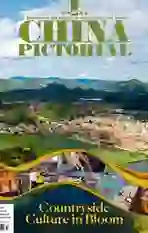Spring of Rural Culture
2022-04-29byYinXing
by Yin Xing

I pick fence-side asters at will, Carefree I see the southern hill.
Excerpt from the poem“Drinking Wine” written by Chinese poet Tao Qian (365-427) and translated by Xu Yuanchong
And then my heart with pleasure fills, And dances with the daffodils.
Excerpt from the poem “The Daffodils” by British poet William Wordsworth (1770-1850)
Throughout the ages in both the East and the West, the literati have tended to seek inner peace and spiritual shelter in rural areas for the natural beauty, modest inhabitants, and rich farming cultures. However, urbanization and modernization caused rural areas to lose much of their allure as young people started leaving for big cities, leaving children and the elderly behind. And even the environment of some rural areas was devastated by resource exploitation for urban construction. Contrasting previous impressions of enchanted landscapes and simple villagers, the countryside was considered a place of poverty, backwardness, and rough sanitary problems.
In 2012, China launched the most resolute poverty alleviation campaign in human history at an unprecedented scale. Most villages in the country made the agenda. The campaign not only lifted everyone in Chinas rural areas out of poverty, but also solved a series of issues that had long haunted poverty-stricken areas in the country, such as transportation, and provision of safe drinking water, electricity, education, healthcare, and communications.
On February 25, 2021, China announced its elimination of absolute poverty in the country, evidenced by rural people enjoying better food, living in larger houses, and having more disposable money. But it was still not the final destination of the campaign. The country subsequently designated a five-year transition period to consolidate the achievements and comprehensively promote rural revitalization to ensure agricultural development becomes more high-quality and efficient, rural areas more livable and business-friendly, farmers more socially astute, and cultures more prosperous.
Rural revitalization involves not just building the shape but nourishing the soul, said Chinese President Xi Jinping. A revitalized village demands not only abundant material wealth but also rich cultural life.
Top Design
Chinas cultural and art sectors should focus on the people and uphold high standards in their activities, according to the nations cultural development plan during the 14th Five-Year Plan period (2021-2025).
The Communist Party of China Central Committee and the State Council, Chinas cabinet, jointly released national guidelines on cultural development in August 2022. The plan aims to promote cultural development and build China into a country with a solid foundation to nurture culture and art.
Dubbing culture the soul of a country, the guidelines seek to complete a network of cultural facilities involving museums, libraries, and art galleries over the next few years to provide stronger support for grassroots communities. Noticeably, it mentioned that cultural resources should also play a key role in the vitalization of rural areas and encouraged local farmers to organize their own art troupes, poetry festivals, and exhibitions.
Responding to the central governments call, local governments at all levels have been promoting renewal of culture in rural areas, investing greater efforts and more funding into rural cultural sectors.
Down to Earth
Cultural expressions can be tangible such as an artwork, a school building, or a library. Culture can also be intangible and involve education, inheritance, and connection to soil. Alongside the governments efforts, social groups and individuals have also been actively participating in revitalizing culture in rural areas. Publishers have opened bookstores in barns. Artists are designing studios in fields. Local farmers operate family hotels on their vacant land. Opening homestays in rural areas has also become a popular choice for entrepreneurs thanks to the increasing popularity of rural tourism and favorable policies on vitalizing the countryside.
“The COVID-19 epidemic changed peoples traveling preferences, helping self-driving and short-distance tours of the countryside outperform traditional long-distance trips,” reported Hu Yang, vice president of Tujia, a property rental platform and homestay operator. “Travelers now prefer trips with more privacy, natural views, and a rural culture experience, so rural homestays are often the best choice.”
Villages with profound cultural legacies have all developed cultural industries. For example, Niejiazhuang, a village in Jiangzhuang Township of Gaomi City, is a cradle of clay sculpture, a national intangible cultural heritage item.
Clay sculptures required hard work for slim profits a few years ago, pushing many people working in the industry to find more rewarding employment. To revive the industry and help locals cash in on their handicrafts, local authorities worked together to improve logistics, technology, management, promotion, and sales. Today, more than 5,000 people in the township are engaged in the research, design, and production of the handicraft products. They produce over 400,000 clay tigers per year, with total annual sales exceeding 10 million yuan (US$1.48 million).
Nie Laichen is the 23rdgeneration practitioner of Niejiazhuang clay sculpture. He sold over 50,000 clay sculptures in the first half of 2022 alone.
“The spring of mud tigers has arrived,” Nie said.
So has culture in Chinas villages, but it still has a long way to go.
